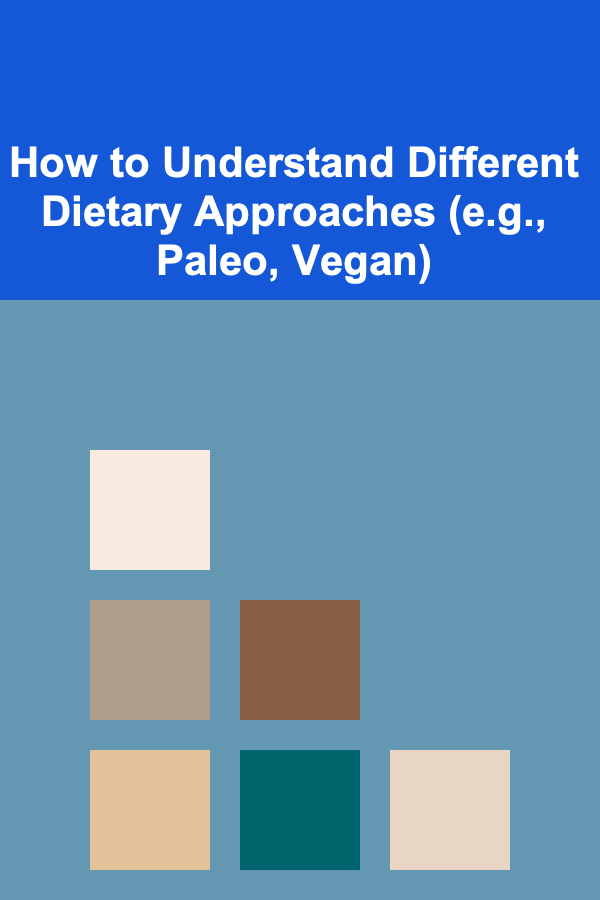
How to Understand Different Dietary Approaches (e.g., Paleo, Vegan)
ebook include PDF & Audio bundle (Micro Guide)
$12.99$7.99
Limited Time Offer! Order within the next:

Dietary approaches are a complex and multifaceted topic, shaped by culture, history, science, and personal preference. With so many diets available, it can be overwhelming to navigate the landscape of dietary choices. Whether it's Paleo, Vegan, Mediterranean, or any other lifestyle, understanding the fundamental principles of each approach is crucial for making informed choices that align with your health, ethical, or environmental values.
This article delves into some of the most popular dietary approaches, focusing on Paleo and Vegan diets, providing a detailed understanding of their principles, benefits, challenges, and the science behind them. Whether you're considering a dietary change, curious about nutrition, or seeking a deeper understanding of modern food movements, this article will help clarify the key aspects of different dietary philosophies.
The Paleo Diet
1.1. Origin and Philosophy
The Paleo diet, often referred to as the "Caveman Diet," is based on the idea of eating like our ancient ancestors. The premise is simple: consume only those foods that would have been available to humans during the Paleolithic era---approximately 2.5 million to 10,000 years ago. The rationale is that our bodies are genetically adapted to the foods our ancestors ate, and modern processed foods have contributed to a rise in chronic diseases such as obesity, diabetes, and heart disease.
The core idea behind the Paleo diet is to eliminate foods that are products of modern agriculture and food processing. This includes grains, legumes, dairy, refined sugars, and processed oils. Instead, it focuses on whole, unprocessed foods that our prehistoric ancestors would have eaten, such as:
- Lean meats (especially grass-fed and wild-caught)
- Fish and seafood
- Fruits and vegetables
- Nuts and seeds
- Healthy fats (such as coconut oil and olive oil)
1.2. Benefits of the Paleo Diet
- Weight Loss: Many individuals report losing weight on the Paleo diet, partly due to the elimination of processed foods and refined sugars. The focus on whole foods helps improve satiety, making it easier to control calorie intake.
- Improved Blood Sugar Control: Because the diet eliminates processed sugars and refined carbohydrates, it may help reduce the risk of type 2 diabetes by improving insulin sensitivity and regulating blood sugar levels.
- Better Digestion: Some people experience improved digestive health as the diet eliminates grains and legumes, which can be difficult to digest for some individuals due to their fiber content and anti-nutrients.
- Increased Energy: By consuming nutrient-dense, whole foods, many individuals report feeling more energized and less fatigued compared to a standard modern diet filled with processed foods.
- Reduced Inflammation: The Paleo diet's emphasis on anti-inflammatory foods, such as omega-3-rich fish and vegetables, can help reduce chronic inflammation, which is a key contributor to various health issues.
1.3. Challenges and Criticisms of the Paleo Diet
While the Paleo diet has its advocates, it also faces significant criticism. Some of the most common criticisms include:
- Lack of Long-Term Research: Although some studies suggest benefits, there is limited long-term research on the Paleo diet. Most evidence is anecdotal or based on short-term studies, which makes it difficult to evaluate its long-term impact on health.
- Nutrient Deficiencies: By eliminating entire food groups such as dairy, grains, and legumes, the Paleo diet can lead to nutrient deficiencies, particularly in calcium, vitamin D, and fiber. These nutrients are found in foods that are excluded from the diet.
- Sustainability: The Paleo diet can be difficult to maintain over time due to its restrictive nature. Many people find it hard to adhere to, especially when dining out or during social gatherings.
- Cost: The emphasis on high-quality, grass-fed meats and organic produce can make the Paleo diet expensive, making it less accessible for individuals on a budget.
The Vegan Diet
2.1. Origin and Philosophy
The Vegan diet is based on the principle of avoiding animal products in all forms. Unlike vegetarianism, which may allow for dairy and eggs, veganism eliminates all animal-derived products, including meat, fish, dairy, eggs, and even honey. The Vegan philosophy extends beyond diet, often encompassing a lifestyle that seeks to reduce harm to animals and the environment.
Vegans focus on plant-based foods, including:
- Fruits and vegetables
- Whole grains
- Legumes
- Nuts and seeds
- Plant-based oils (such as olive oil and avocado oil)
Veganism is often associated with ethical concerns regarding animal welfare, environmental sustainability, and health. Many individuals adopt a vegan diet to reduce animal suffering, lower their ecological footprint, or for perceived health benefits.
2.2. Benefits of the Vegan Diet
- Ethical and Environmental Impact: Veganism is driven by a desire to reduce animal suffering and environmental degradation. Animal agriculture is a major contributor to climate change, deforestation, and water pollution, and choosing a plant-based diet is seen as a way to minimize these impacts.
- Health Benefits: Several studies suggest that a well-planned vegan diet can lead to numerous health benefits, including lower rates of heart disease, high blood pressure, and certain cancers. Vegans tend to have lower cholesterol levels, reduced body fat, and a lower risk of chronic diseases.
- Weight Management: Many individuals adopt a vegan diet for weight management, as plant-based diets are often lower in calories and fat while being high in fiber, which can promote feelings of fullness and reduce overall calorie consumption.
- Improved Digestive Health: A vegan diet is typically high in fiber, which promotes healthy digestion, reduces constipation, and supports a healthy gut microbiome. The diet is also rich in antioxidants, which may help reduce inflammation and oxidative stress in the body.
- Reduced Risk of Chronic Diseases: Vegans typically have lower rates of type 2 diabetes, cardiovascular diseases, and obesity. Plant-based diets are rich in vitamins, minerals, and phytochemicals, which support overall health and protect against disease.
2.3. Challenges and Criticisms of the Vegan Diet
Despite the many benefits of a vegan diet, it also has its share of challenges and criticisms:
- Nutrient Deficiencies: One of the most significant challenges of the vegan diet is ensuring adequate intake of certain nutrients, including vitamin B12, vitamin D, omega-3 fatty acids, iron, and calcium. These nutrients are primarily found in animal-based products, so vegans must carefully plan their diet to include fortified foods or supplements.
- Social and Cultural Challenges: Veganism can be socially isolating, especially in cultures where meat is a central part of the diet. Dining out, attending social events, and traveling can pose significant challenges for those following a vegan lifestyle.
- Over-Reliance on Processed Foods: While a plant-based diet can be incredibly nutritious, many processed vegan foods are high in sugar, salt, and unhealthy fats. It's important for vegans to focus on whole foods rather than relying on packaged and processed alternatives.
- Potential for Unbalanced Diet: Without careful planning, a vegan diet can lead to an unbalanced intake of macronutrients, particularly protein. It's essential for vegans to incorporate a variety of plant-based protein sources such as lentils, tofu, quinoa, and tempeh.
Common Misconceptions
3.1. "Paleo is All About Eating Meat"
While the Paleo diet does emphasize meat, it is not solely about consuming animal products. The diet encourages a balanced intake of vegetables, fruits, nuts, and seeds, with meat as one component of a whole-foods approach. Lean meats, especially those from grass-fed or wild-caught animals, are prioritized, but plant-based foods play a significant role in the diet.
3.2. "Vegans Can't Get Enough Protein"
A common misconception about the Vegan diet is that it lacks sufficient protein. In reality, there are numerous plant-based sources of protein, including lentils, chickpeas, quinoa, soy products, and various nuts and seeds. As long as a variety of plant proteins is consumed, it's entirely possible for vegans to meet their protein needs.
3.3. "The Vegan Diet is Always Healthy"
While a vegan diet can be incredibly healthy, it is not automatically so. A vegan diet based on junk food, such as fries, sugary snacks, and processed vegan meats, can still be unhealthy. The key to a healthy vegan diet lies in choosing whole, nutrient-dense foods and being mindful of nutrient intake.
Conclusion
Dietary approaches like Paleo and Veganism offer alternative ways of eating, each with its unique philosophy and benefits. The Paleo diet draws inspiration from our ancient ancestors, focusing on whole, unprocessed foods, while the Vegan diet emphasizes plant-based eating and ethical considerations regarding animal welfare.
Both diets can promote health benefits, such as weight loss, improved digestion, and reduced inflammation. However, they also come with challenges, particularly in terms of nutrient deficiencies and social obstacles. Ultimately, the best dietary approach is the one that aligns with your individual goals, preferences, and ethical beliefs. Understanding the science and principles behind these diets can help you make informed choices about your health and well-being, ensuring that your dietary decisions are based on evidence and personal values.
Whether you choose to embrace the Paleo diet's return to ancestral eating habits or the Vegan diet's commitment to plant-based living, both approaches offer valuable lessons about how food can shape our health and impact the world around us.
Other Products

Creating a Digital Educational Game: An Actionable Guide
Read More
How to Configure Shipping Settings for Your Shopify Dropshipping Store
Read More
How to Decorate Your Kitchen with Holiday Accents for a Cheerful Vibe
Read More
How to Find Free or Low-Cost Entertainment Options
Read More
How to Plan for Retirement with Long-Term Investments
Read More